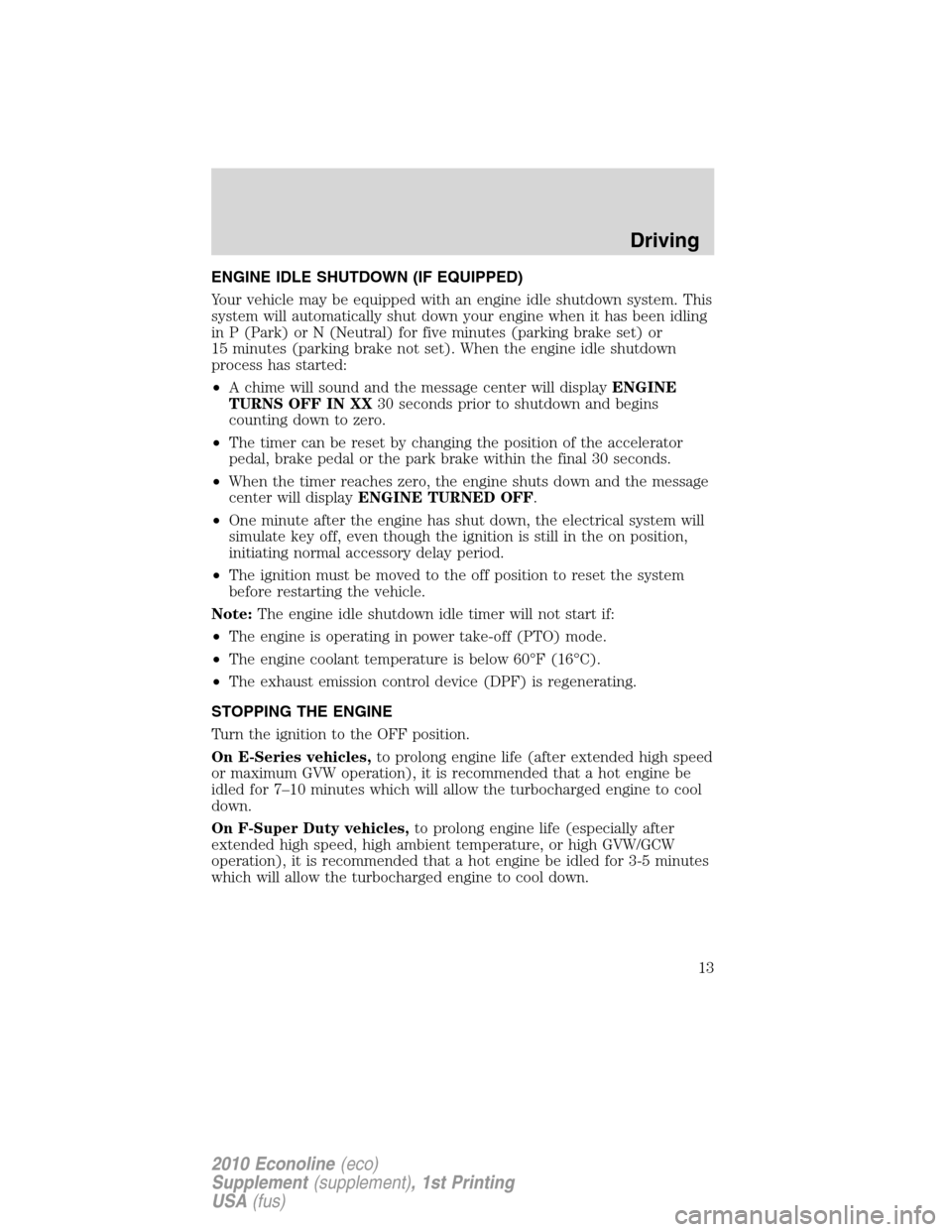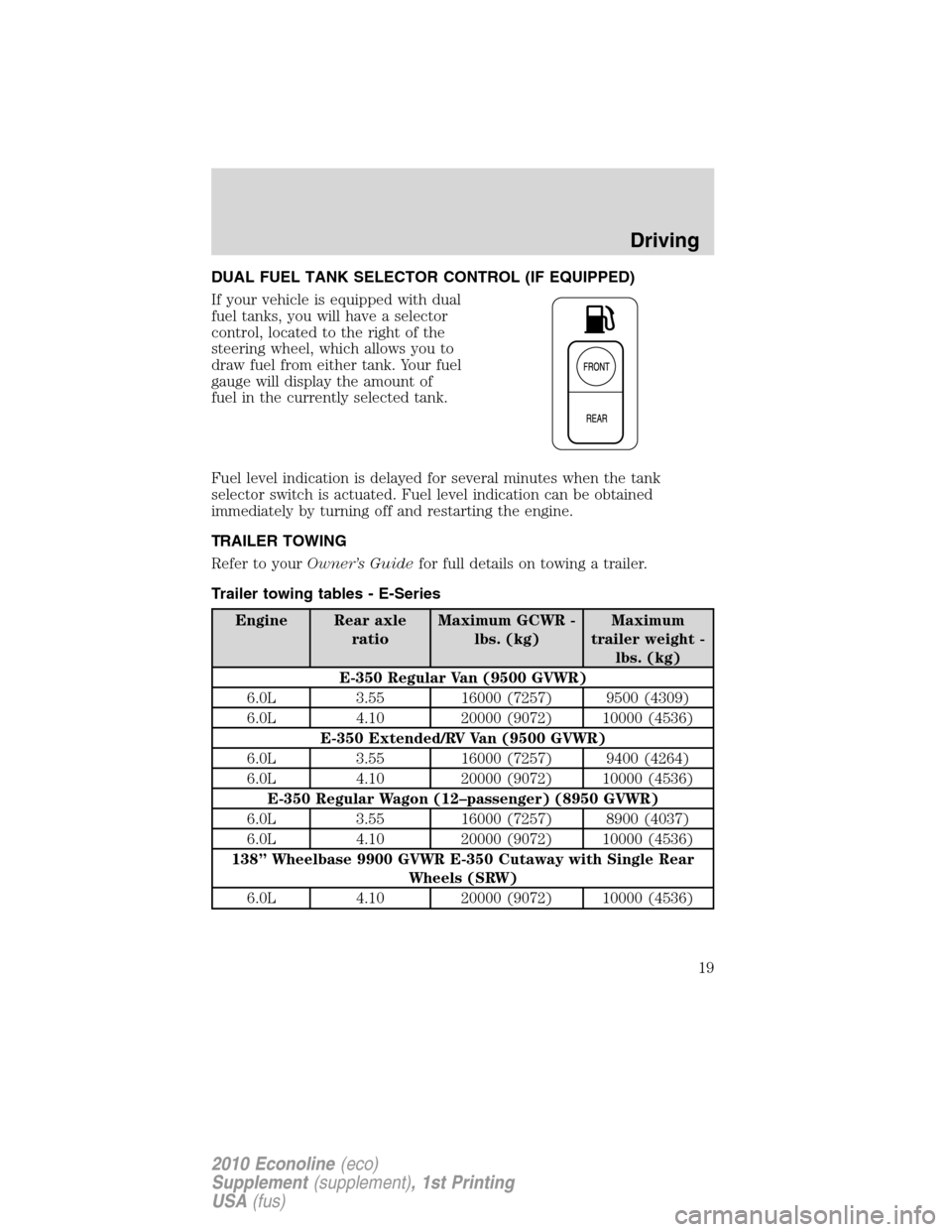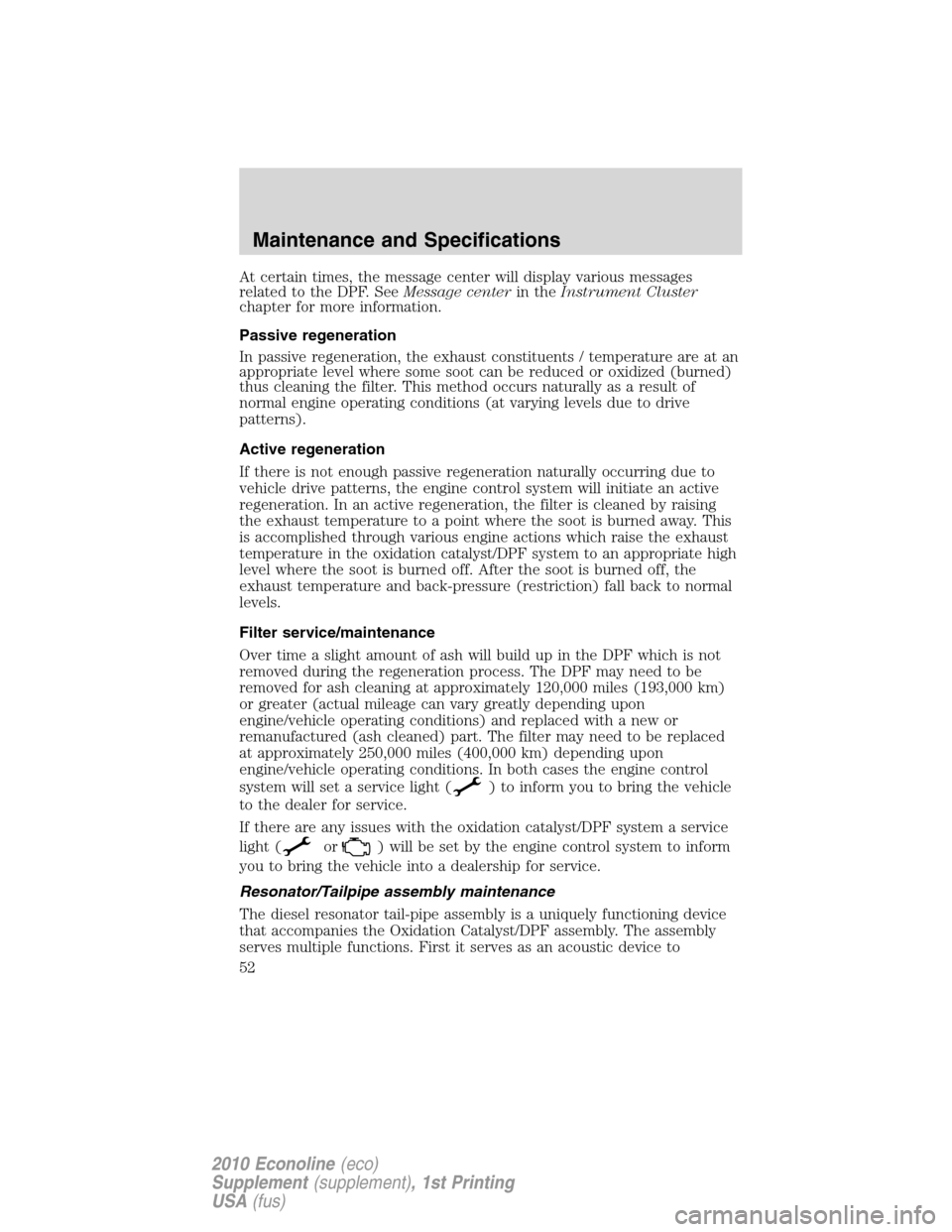Page 8 of 104
F-Super Duty w/automatic transmission
Harley-Davidson
Note:Some warning lights are reconfigurable telltale (RTT) indicator
lights and will illuminate in the message center display and function the
same as the warning light.
Instrument Cluster
8
2010 Econoline(eco)
Supplement(supplement), 1st Printing
USA(fus)
Page 13 of 104

ENGINE IDLE SHUTDOWN (IF EQUIPPED)
Your vehicle may be equipped with an engine idle shutdown system. This
system will automatically shut down your engine when it has been idling
in P (Park) or N (Neutral) for five minutes (parking brake set) or
15 minutes (parking brake not set). When the engine idle shutdown
process has started:
•A chime will sound and the message center will displayENGINE
TURNS OFF IN XX30 seconds prior to shutdown and begins
counting down to zero.
•The timer can be reset by changing the position of the accelerator
pedal, brake pedal or the park brake within the final 30 seconds.
•When the timer reaches zero, the engine shuts down and the message
center will displayENGINE TURNED OFF.
•One minute after the engine has shut down, the electrical system will
simulate key off, even though the ignition is still in the on position,
initiating normal accessory delay period.
•The ignition must be moved to the off position to reset the system
before restarting the vehicle.
Note:The engine idle shutdown idle timer will not start if:
•The engine is operating in power take-off (PTO) mode.
•The engine coolant temperature is below 60°F (16°C).
•The exhaust emission control device (DPF) is regenerating.
STOPPING THE ENGINE
Turn the ignition to the OFF position.
On E-Series vehicles,to prolong engine life (after extended high speed
or maximum GVW operation), it is recommended that a hot engine be
idled for 7–10 minutes which will allow the turbocharged engine to cool
down.
On F-Super Duty vehicles,to prolong engine life (especially after
extended high speed, high ambient temperature, or high GVW/GCW
operation), it is recommended that a hot engine be idled for 3-5 minutes
which will allow the turbocharged engine to cool down.
Driving
13
2010 Econoline(eco)
Supplement(supplement), 1st Printing
USA(fus)
Page 19 of 104

DUAL FUEL TANK SELECTOR CONTROL (IF EQUIPPED)
If your vehicle is equipped with dual
fuel tanks, you will have a selector
control, located to the right of the
steering wheel, which allows you to
draw fuel from either tank. Your fuel
gauge will display the amount of
fuel in the currently selected tank.
Fuel level indication is delayed for several minutes when the tank
selector switch is actuated. Fuel level indication can be obtained
immediately by turning off and restarting the engine.
TRAILER TOWING
Refer to yourOwner’s Guidefor full details on towing a trailer.
Trailer towing tables - E-Series
Engine Rear axle
ratioMaximum GCWR -
lbs. (kg)Maximum
trailer weight -
lbs. (kg)
E-350 Regular Van (9500 GVWR)
6.0L 3.55 16000 (7257) 9500 (4309)
6.0L 4.10 20000 (9072) 10000 (4536)
E-350 Extended/RV Van (9500 GVWR)
6.0L 3.55 16000 (7257) 9400 (4264)
6.0L 4.10 20000 (9072) 10000 (4536)
E-350 Regular Wagon (12–passenger) (8950 GVWR)
6.0L 3.55 16000 (7257) 8900 (4037)
6.0L 4.10 20000 (9072) 10000 (4536)
138” Wheelbase 9900 GVWR E-350 Cutaway with Single Rear
Wheels (SRW)
6.0L 4.10 20000 (9072) 10000 (4536)
Driving
19
2010 Econoline(eco)
Supplement(supplement), 1st Printing
USA(fus)
Page 52 of 104

At certain times, the message center will display various messages
related to the DPF. SeeMessage centerin theInstrument Cluster
chapter for more information.
Passive regeneration
In passive regeneration, the exhaust constituents / temperature are at an
appropriate level where some soot can be reduced or oxidized (burned)
thus cleaning the filter. This method occurs naturally as a result of
normal engine operating conditions (at varying levels due to drive
patterns).
Active regeneration
If there is not enough passive regeneration naturally occurring due to
vehicle drive patterns, the engine control system will initiate an active
regeneration. In an active regeneration, the filter is cleaned by raising
the exhaust temperature to a point where the soot is burned away. This
is accomplished through various engine actions which raise the exhaust
temperature in the oxidation catalyst/DPF system to an appropriate high
level where the soot is burned off. After the soot is burned off, the
exhaust temperature and back-pressure (restriction) fall back to normal
levels.
Filter service/maintenance
Over time a slight amount of ash will build up in the DPF which is not
removed during the regeneration process. The DPF may need to be
removed for ash cleaning at approximately 120,000 miles (193,000 km)
or greater (actual mileage can vary greatly depending upon
engine/vehicle operating conditions) and replaced with a new or
remanufactured (ash cleaned) part. The filter may need to be replaced
at approximately 250,000 miles (400,000 km) depending upon
engine/vehicle operating conditions. In both cases the engine control
system will set a service light (
) to inform you to bring the vehicle
to the dealer for service.
If there are any issues with the oxidation catalyst/DPF system a service
light (
or) will be set by the engine control system to inform
you to bring the vehicle into a dealership for service.
Resonator/Tailpipe assembly maintenance
The diesel resonator tail-pipe assembly is a uniquely functioning device
that accompanies the Oxidation Catalyst/DPF assembly. The assembly
serves multiple functions. First it serves as an acoustic device to
Maintenance and Specifications
52
2010 Econoline(eco)
Supplement(supplement), 1st Printing
USA(fus)